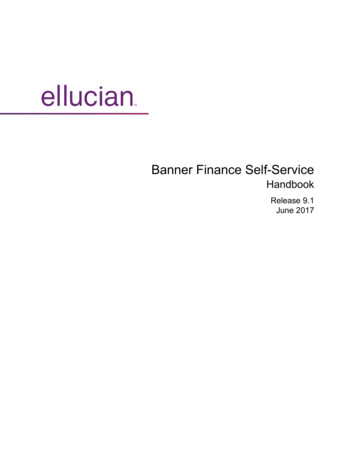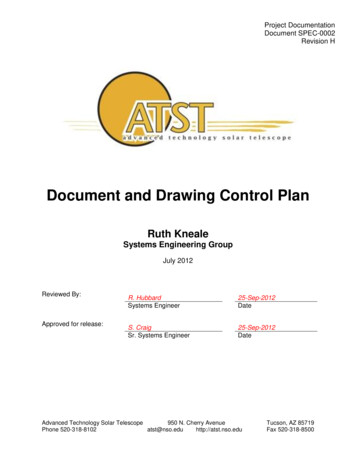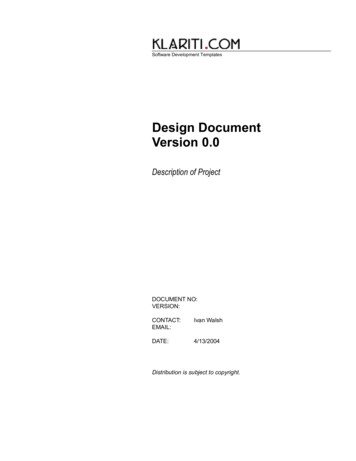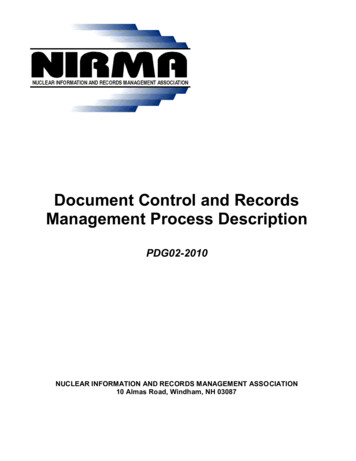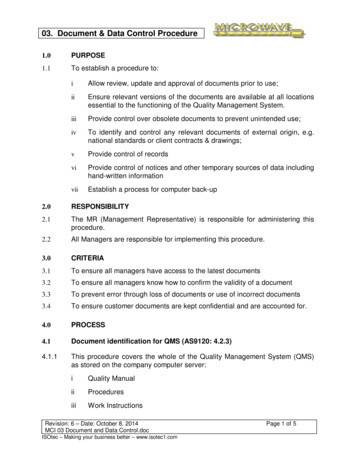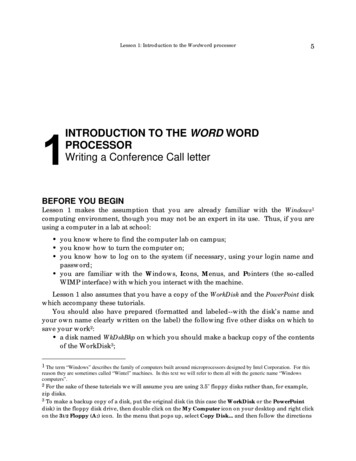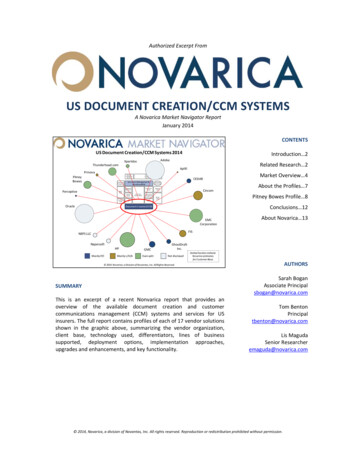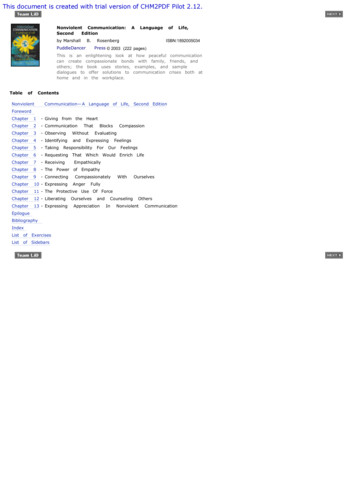
Transcription
This document is created with trial version of CHM2PDF Pilot 2.12.Nonviolent Communication:SecondEditionby N:1892005034Press 2003 (222 pages)This is an enlightening look at how peaceful communicationcan create compassionate bonds with family, friends, andothers; the book uses stories, examples, and sampledialogues to offer solutions to communication crises both athome and in the workplace.TableofContentsNonviolentCommunicationÑ A Language of Life, Second EditionForewordChapter1- Giving from the HeartChapter2- CommunicationChapter3- ObservingWithoutChapter4- IdentifyingandChapter5- TakingChapter6- Requesting That Which Would Enrich LifeChapter7- ReceivingChapter8- The Power of EmpathyChapter9- ConnectingChapter10 - ExpressingChapter11 - The Protective Use Of ForceChapter12 - LiberatingChapter13 - List of OurselvesandAppreciationInNonviolentCommunication
This document is created with trial version of CHM2PDF Pilot 2.12.BackCoverMost of us have been educated from birth to compete, judge, demand, diagnoseÑ to think and communicate in terms of what is Òright Óand Òwrong Ó with people. At best, the habitual ways we think and speak hinder communication, and crate misunderstanding andfrustration in others and in ourselves. And still worse, they cause anger and pain, and may lead to violence. Without wanting to, evenpeople with the best of intentions generate needless conflict.In Nonviolent Communication: A Language of Life, Marshall Rosenberg shows us how to reach beneath the surface and discover whatis alive and vital within us, and how all of our actions are based on human needs that we are seeking to meet. When we understandand acknowledge our needs we create a shared basis for a more satisfying relationshipÑ a deeper connection with others andourselves. Join the thousands of people world-wide who have improved their relationshipsÑ and their livesÑ with this simple, psyou:nFree yourself from the effects of past experiences and cultural conditioningnBreak patterns of thinking that lead to arguments, anger and veryoneÕs needs being AuthorMarshall Rosenberg, Ph.D., is the founder and educational director of the Center for Nonviolent Communication (CNVC). He travelsthroughout the world mediating conflict and promoting peace.
This document is created with trial version of CHM2PDF Pilot 2.12.Nonviolent Communication—A Language of Life, Second EditionMarshall B. Rosenberg, Ph.D.P.O. Box 231129, Encinitas, CA 92023-1129email@PuddleDancer.com www.PuddleDancer.comAll rights reserved. No part of this book may be reproduced by any mechanical, photographic, or electronic process, or in the formof a photographic recording, nor may it be stored in a retrieval system, transmitted or otherwise copied for public or private usewithout the written permission of the publisher. Requests for permission should be addressed to:PuddleDancer Press, Permissions Dept.P.O. Box 231129, Encinitas, CA 92023-1129Fax: 1-858-759-6967, email@PuddleDancer.comNonviolent Communication: A Language of Life2nd Edition Printing, August, 2003Author: Marshall B. Rosenberg, Ph.D.Editor: Lucy LeuProject Director: Jeanne IlerCover and Interior Design: Lightbourne, www.lightbourne.comCover photograph of Jerusalem artichoke: Eric DresserManufactured in the United States of America10 9 8 7 6 5 4 3 2 1ISBN: 1-892005-03-4Library of Congress Cataloging-in-Publication DataRosenberg, Marshall B.Nonviolent communication : a language of life / by Marshall B. Rosenberg. -- 2nd ed.p. cm. Includes bibliographical references and index.ISBN: 1-892005-03-41. Interpersonal communication. 2. Interpersonal relations. I. Title.BF637.C45R67 2003 153.6--dc212003010831AcknowledgementsI’m grateful that I was able to study and work with Professor Carl Rogers at a time when he was researching the components of ahelping relationship. The results of this research played a key role in the evolution of the process of communication that I will bedescribing in this book.I will be forever grateful that Professor Michael Hakeem helped me to see the scientific limitations and the social and politicaldangers of practicing psychology in the way that I had been trained: a pathology-based understanding of human beings. Seeingthe limitations of this model stimulated me to search for ways of practicing a different psychology, one based on a growing clarityabout how we human beings were meant to live.I’m grateful, too, for George Miller’s and George Albee’s efforts to alert psychologists to the need of finding better ways for “givingpsychology away.” They helped me see that the enormity of suffering on our planet requires more effective ways of distributingmuch-needed skills than can be offered by a clinical approach.I would like to thank Lucy Leu for editing this book and creating-the final manuscript; Rita Herzog and Kathy Smith for their editingassistance; and for the additional help of Darold Milligan, Sonia Nordenson, Melanie Sears, Bridget Belgrave, Marian Moore,Kittrell McCord, Virginia Hoyte, and Peter Weismiller.Finally, I would like to express gratitude to my friend Annie Muller. Her encouragement to be clearer about the spiritual foundationof my work has strengthened that work and enriched my life.About The AuthorMARSHALL B. ROSENBERG, PH.D. is Founder and Director of Educational Services for the Center for Nonviolent Communication(CNVC).Growing up in a turbulent Detroit neighborhood, Dr. Rosenberg developed a keen interest in new forms of communication thatwould provide peaceful alternatives to the violence he encountered. His interest led to a Ph.D. in clinical psychology from the
ThisUniversitydocumentis createdwith trialversion of2.12.of Wisconsinin 1961.His subsequentlifeCHM2PDFexperience Pilotand studyof comparative religion motivated him to developNonviolent Communication (NVC).Dr. Rosenberg first used NVC in federally funded projects to provide mediation and communication skills training during the 1960s.He founded the Center for Nonviolent Communication (CNVC) in 1984. Since then CNVC has grown into an international nonprofitorganization with over 100 trainers. They provide training in 30 countries in North and South America, Europe, Asia, the MiddleEast, and Africa, and offer workshops for educators, counselors, parents, health care providers, mediators, business managers,prison inmates and guards, police, military personnel, clergy, and government officials.Dr. Rosenberg has initiated peace programs in war torn areas including Rwanda, Burundi, Nigeria, Malaysia, Indonesia, Sri Lanka,Sierra Leone, the Middle East, Colombia, Serbia, Croatia, and Northern Ireland. Funded by UNESCO, the CNVC team inYugoslavia has trained tens of thousands of students and teachers. The government of Israel has officially recognized NVC and isnow offering training in hundreds of schools in that country.Dr. Rosenberg is currently based in Wasserfallenhof, Switzerland, and travels regularly offering NVC training and conflictmediation.
This document is created with trial version of CHM2PDF Pilot 2.12.ForewordArun GandhiFounder/President, M.K. Gandhi Institute for NonviolenceGrowing up as a person of color in apartheid South Africa in the 1940’s was not something anyone relished. This was especiallytrue if you were brutally reminded of your skin color every moment of every day. And then to be beaten up at the age of ten bywhite youths because they considered you too black, and then by black youths because they considered you too white, is ahumiliating experience that could drive anyone to vengeful violence.I was so outraged by my experiences that my parents decided to take me to India and leave me for some time with grandfather,the legendry M. K. Gandhi, so that I could learn from him how to deal with the anger, the frustration, the discrimination, and thehumiliation that violent color prejudice can evoke in you. In those 18 months I learned more than I anticipated. My only regret nowis that I was just 13 years old and a mediocre student at that. If only I was older, a bit wiser and a bit more thoughtful, I could havelearned so much more. But one must be happy with what one has received and not be greedy—a fundamental lesson in nonviolentliving. How can I forget this?One of the many things I learned from grandfather is to understand the depth and breadth of nonviolence, and to acknowledge thatwe are all violent and that we need to bring about a qualitative change in our attitudes. We often don’t acknowledge our violencebecause we are ignorant about it. We assume we are not violent because our vision of violence is one of fighting, killing, beating,and wars—the type of things that average individuals don’t do.To bring this home to me, grandfather made me draw a family tree of violence using the same principles as are used for agenealogical tree. His argument was that I would have a better appreciation of nonviolence if I understood and acknowledged theviolence that exists in the world. He assisted me every evening to analyze the day’s happenings—everything that I experienced,read about, saw or did to others—and put them down on the tree either under “physical ” (if it was violence where physical forcewas used) or under “passive” (if it was the type of violence where the hurt was more emotional).Within a few months I covered one wall in my room with acts of “passive" violence that grandfather described as being moreinsidious than “physical" violence. He then explained that passive violence ultimately generated anger in the victim who, as anindividual or as a member of a collective, responded violently. In other words it is passive violence that fuels the fire of physicalviolence. It is because we don’t understand or appreciate this concept that all our efforts to work for peace have either notfructified, or the peace that we achieved was only temporary. How can we extinguish a fire if we don’t first cut off the fuel thatignites the inferno?Grandfather always vociferously stressed the need for nonviolence in communications—something that Marshall Rosenberg hasbeen doing admirably for many years through his writings and his seminars. I read with considerable interest Mr. Rosenberg’sbook, Nonviolent Communication—A Language of Life, and was impressed by the depth of his work and the simplicity of thesolutions.Unless, as grandfather would say, “we become the change we wish to see in the world,” no change will ever take place. We areall, unfortunately, waiting for the other person to change first.Nonviolence is not a strategy that can be used today and discarded tomorrow, nor is it something that makes you meek or apushover. Nonviolence is about inculcating positive attitudes to replace the negative attitudes that dominate us. Everything that wedo is conditioned by selfish motives—what’s in it for me—and even more so in an overwhelmingly materialistic society that thriveson rugged individualism. None of these negative concepts is conducive to building a homogeneous family, community, society, ornation.It is not important that we come together in a moment of crisis-and show our patriotism by flying the flag; it is not enough that webecome a superpower by building an arsenal that can destroy this earth several times over; it is not enough that we subjugate therest of the world through our military might, because peace cannot be built on the foundations of fear.Nonviolence means allowing the positive within you to emerge. Be dominated by love, respect, understanding, appreciation,compassion, and concern for others rather than the self-centered and selfish, greedy, hateful, prejudiced, suspicious, andaggressive attitudes that usually dominate our thinking. We often hear people say: “This world is ruthless and if you want to surviveyou must become ruthless, too.” I humbly disagree with this contention.This world is what we have made of it. If it is ruthless today it is because we have made it ruthless by our attitudes. If we changeourselves we can change the world, and changing ourselves begins with changing our language and methods of communication. Ihighly recommend reading this book, and applying the Nonviolent Communication process it teaches. It is a significant first steptowards changing our communication and creating a compassionate world.—Arun GandhiWords are Windows (or They’re Walls)I feel so sentenced by your words,I feel so judged and sent away,Before I go I’ve got to know
This documentcreatedwithtrial version of CHM2PDF Pilot 2.12.Is that iswhatyou meanto say?Before I rise to my defense,Before I speak in hurt or fear,Before I build that wall of words,Tell me, did I really hear?Words are windows, or they’re walls,They sentence us, or set us free.When I speak and when I hear,Let the love light shine through me.There are things I need to say,Things that mean so much to me,If my words don’t make me clear,Will you help me to be free?If I seemed to put you down,If you felt I didn’t care,Try to listen through my wordsTo the feelings that we share.—Ruth Bebermeyer
This document is created with trial version of CHM2PDF Pilot 2.12.Chapter 1: Giving from the HeartThe Heart of Nonviolent CommunicationWhat I want in my life is compassion, a flow between myself and others based on a mutual giving from the heart.—Marshall Rosenberg
This document is created with trial version of CHM2PDF Pilot 2.12.IntroductionBelieving that it is our nature to enjoy giving and receiving in a compassionate manner, I have been preoccupied most of my lifewith two questions. What happens to disconnect us from our compassionate nature, leading us to behave violently andexploitatively? And conversely, what allows some people to stay connected to their compassionate nature under even the mosttrying circumstances?My preoccupation with these questions began in childhood, around the summer of 1943, when our family moved to Detroit,Michigan. The second week after we arrived, a race war erupted over an incident at a public park. More than forty people werekilled in the next few days. Our neighborhood was situated in the center of the violence, and we spent three days locked in thehouse.When the race riot ended and school began, I discovered that a name could be as dangerous as any skin color. When the teachercalled my name during attendance, two boys glared at me and hissed, “Are you a kike?” I had never heard the word before anddidn’t know some people used it in a derogatory way to refer to Jews. After school, the two were waiting for me: they threw me tothe ground, kicked and beat me.Since that summer in 1943, I have been examining the two questions I mentioned. What empowers us, for example, to stayconnected to our compassionate nature even under the worst circumstances? I am thinking of people like Etty Hillesum, whoremained compassionate even while subjected to the grotesque conditions of a German concentration camp. As she wrote in herjournal at the time,I“am not easily frightened. Not because I am brave but because I know that I am dealing with human beings, and thatI must try as hard as I can to understand everything that anyone ever does. And that was the real import of thismorning: not that a disgruntled young Gestapo officer yelled at me, but that I felt no indignation, rather a realcompassion, and would have liked to ask, ‘Did you have a very unhappy childhood, has your girlfriend let you down?’Yes, he looked harassed and driven, sullen and weak. I should have liked to start treating him there and then, for Iknow that pitiful young men like that are dangerous as soon as they are let loose on mankind.—Etty Hillesum: A Diary.While studying the factors that affect our ability to stay compassionate, I was struck by the crucial role of language and our use ofwords. I have since identified a specific approach to communicating—speaking and listening—that leads us to give from the heart,connecting us with ourselves and with each other in a way that allows our natural compassion to flourish. I call this approachNonviolent Communication, using the term nonviolence as Gandhi used it—to refer to our natural state of compassion whenviolence has subsided from the heart. While we may not consider the way we talk to be “violent,” our words often lead to hurt andpain, whether for others or ourselves. In some communities, the process I am describing is known as CompassionateCommunication; the abbreviation “NVC” is used throughout this book to refer to Nonviolent or Compassionate Communication.NVC: a way of communicating that leads us to give from the heart.
This document is created with trial version of CHM2PDF Pilot 2.12.A Way To Focus AttentionNVC is founded on language and communication skills that strengthen our ability to remain human, even under trying conditions. Itcontains nothing new; all that has been integrated into NVC has been known for centuries. The intent is to remind us about whatwe already know—about how we humans were meant to relate to one another—and to assist us in living in a way that concretelymanifests this knowledge.NVC guides us in reframing how we express ourselves and hear others. Instead of being habitual, automatic reactions, our wordsbecome conscious responses based firmly on an awareness of what we are perceiving, feeling, and wanting. We are led toexpress ourselves with honesty and clarity, while simultaneously paying others a respectful and empathic attention. In anyexchange, we come to hear our own deeper needs and those of others. NVC trains us to observe carefully, and to be able tospecify behaviors and conditions that are affecting us. We learn to identify and clearly articulate what we are concretely wanting ina given situation. The form is simple, yet powerfully transformative.As NVC replaces our old patterns of defending, withdrawing, or attacking in the face of judgment and criticism, we come toperceive ourselves and others, as well as our intentions and relationships, in a new light. Resistance, defensiveness, and violentreactions are minimized. When we focus on clarifying what is being observed, felt, and needed rather than on diagnosing andjudging, we discover the depth of our own compassion. Through its emphasis on deep listening—to ourselves as well as others—NVC fosters respect, attentiveness, and empathy, and engenders a mutual desire to give from the heart.We perceive relationships in a new light when we use NVC to hear our own deeper needs and those ofothers.Although I refer to it as “a process of communication” or a “language of compassion,” NVC is more than a process or a language.On a deeper level, it is an ongoing reminder to keep our attention focused on a place where we are more likely to get what we areseeking.There is a story of a man under a street lamp searching for something on all fours. A policeman passing by asked what he wasdoing. “Looking for my car keys,” replied the man, who appeared slightly drunk. “Did you drop them here?” inquired the officer.“No,” answered the man, “I dropped them in the alley.” Seeing the policeman’s baffled expression, the man hastened to explain,“But the light is much better here.”I find that my cultural conditioning leads me to focus attention on places where I am unlikely to get what I want. I developed NVCas a way to train my attention—to shine the light of consciousness—on places that have the potential to yield what I am seeking.What I want in my life is compassion, a flow between myself and others based on a mutual giving from the heart.Let’s shine the light of consciousness on places where we can hope to find what we are seeking.This quality of compassion, which I refer to as “giving from the heart,” is expressed in the following lyrics by my friend, RuthBebermeyer:I never feel more given tothan when you take from me —when you understand the joy I feelgiving to you.And you know my giving isn’t doneto put you in my debt,but because I want to live the loveI feel for you.To receive with gracemay be the greatest giving.There’s no way I can separatethe two.When you give to me,I give you my receiving.When you take from me, I feel sogiven to.—Song “Given To” (1978) by Ruth Bebermeyer from the album, Given To.When we give from the heart, we do so out of a joy that springs forth whenever we willingly enrich another person’s life. This kind ofgiving benefits both the giver and the receiver. The receiver enjoys the gift without worrying about the consequences thataccompany gifts given out of fear, guilt, shame, or desire for gain. The giver benefits from the enhanced self-esteem that resultswhen we see our efforts contributing to someone’s well-being.The use of NVC does not require that the persons with whom we are communicating be literate in NVC or even motivated to relateto us compassionately. If we stay with the principles of NVC, motivated solely to give and receive compassionately, and doeverything we can to let others know this is our only motive, they will join us in the process and eventually we will be able to
Thisresponddocumentis created towithversionCHM2PDFPilot2.12.compassionatelyone trialanother.I’m notofsayingthat thisalwayshappens quickly. I do maintain, however, thatcompassion inevitably blossoms when we stay true to the principles and process of NVC.
This document is created with trial version of CHM2PDF Pilot 2.12.The NVC ProcessTo arrive at a mutual desire to give from the heart, we focus the light of consciousness on four areas—referred to as the fourcomponents of the NVC model.First, we observe what is actually happening in a situation: what are we observing others saying or doing that is either enriching ornot enriching our life? The trick is to be able to articulate this observation without introducing any judgment or evaluation—tosimply say what people are doing that we either like or don’t like. Next, we state how we feel when we observe this action: are wehurt, scared, joyful, amused, irritated, etc.? And thirdly, we say what needs of ours are connected to the feelings we haveidentified. An awareness of these three components is present when we use NVC to clearly and honestly express how we are.Four components of NVC:1.2.3.4.observationfeelingneedsrequestFor example, a mother might express these three pieces to her teenage son by saying, “Felix, when I see two balls of soiledsocks under the coffee table and another three next to the TV, I feel irritated because I am needing more order in the rooms thatwe share in common.”She would follow immediately with the fourth component—a very specific request: “Would you be willing to put your socks in yourroom or in the washing machine?” This fourth component addresses what we are wanting from the other person that would enrichour lives or make life more wonderful for us.Thus, part of NVC is to express these four pieces of information very clearly, whether verbally or by other means. The other aspectof this communication consists of receiving the same four pieces of information from others. We connect with them by firstsensing what they are observing, feeling, and needing, and then discover what would enrich their lives by receiving the fourth piece,their request.As we keep our attention focused on the areas mentioned, and help others do likewise, we establish a flow of communication,back and forth, until compassion manifests naturally: what I am observing, feeling, and needing; what I am requesting to enrich mylife; what you are observing, feeling, and needing; what you are requesting to enrich your life. . . .NVC ProcessThe concrete actions we areobserving that are affecting our well-beingHow we feel in relationto what we are observingThe needs, values, desires, etc.that are creating our feelingsThe concrete actions we requestin order to enrich our livesWhen we use this process, we may begin either by expressing ourselves or by empathically receiving these four pieces ofinformation from others. Although we will learn to listen for and verbally express each of these components in Chapters 3–6, it isimportant to keep in mind that NVC does not consist of a set formula, but adapts to various situations as well as personal andcultural styles. While I conveniently refer to NVC as a “process ” or “language,” it is possible to experience all four pieces of theprocess without uttering a single word. The essence of NVC is to be found in our consciousness of these four components, not inthe actual words that are exchanged.Two parts of NVC:1. expressing honesty through the four components2. receiving empathically through the four components
This document is created with trial version of CHM2PDF Pilot 2.12.Applying NVC In Our Lives And WorldWhen we use NVC in our interactions—with ourselves, with another person, or in a group—we become grounded in our naturalstate of compassion. It is therefore an approach that can be effectively applied at all levels of communication and in diversesituations:intimate relationshipsfamiliesschoolsorganizations and institutionstherapy and counselingdiplomatic and business negotiationsdisputes and conflicts of any natureSome people use NVC to create greater depth and caring in their intimate relationships:When I learned how I can receive (hear), as well as give (express), through using NVC, I went beyond feelingattacked and ‘door mattish’ to really listening to words and extracting their underlying feelings. I discovered a veryhurting man to whom I had been married for 28 years. He had asked me for a divorce the weekend before the [NVC]workshop. To make a long story short, we are here today—together, and I appreciate the contribution [it has] madeto our happy ending. . . . I learned to listen for feelings, to express my needs, to accept answers that I didn’t alwayswant to hear. He is not here to make me happy, nor am I here to create happiness for him. We have both learned togrow, to accept and to love, so that we can each be fulfilled.—workshop participant in San DiegoOthers use it to build more effective relationships at work. A teacher writes:I have been using NVC in my special education classroom for about one year. It can work even with children whohave language delays, learning difficulties, and behavior problems. One student in our classroom spits, swears,screams, and stabs other students with pencils when they get near his desk. I cue him with, ‘Please say thatanother way. Use your giraffe talk.’ [Giraffe puppets are used in some workshops as a teaching aid to demonstrateNVC.] He immediately stands up straight, looks at the person towards whom his anger is directed, and says calmly,‘Would you please move away from my desk? I feel angry when you stand so close to me.’ The other students mightrespond with something like ‘Sorry! I forgot it bothers you.’I began to think about my frustration with this child and to try to discover what I needed from him (besides harmonyand order). I realized how much time I had put into lesson planning and how my need for creativity and contributionwere being short-circuited in order to manage behavior. Also, I felt I was not meeting the educational needs of theother students. When he was acting out in class, I began to say, ‘I need you to share my attention.’ It might take ahundred cues a day, but he got the message and would usually get involved in the lesson.—teacher, Chicago, IllinoisA doctor writes:I use NVC more and more in my medical practice. Some patients ask me whether I am a psychologist, saying thatusually their doctors are not interested in the way they live their lives or deal with their diseases. NVC helps meunderstand what the patients’ needs are and what they need to hear at a given moment. I find this particularly helpfulin relating to patients with hemophilia and AIDS because there is so much anger and pain that the patient/healthcare provider relationship is often seriously impaired. Recently a woman with AIDS, whom I have been treatingfor the past five years, told me that what has helped her the most have been my attempts to find ways for her toenjoy her daily life. My use of NVC helps me a lot in this respect. Often in the past, when I knew that a patient had afatal disease, I myself would get caught in the prognosis, and it was hard for me to sincerely encourage them to livetheir lives. With NVC, I have developed a new consciousness as well as a new language. I am amazed to see howmuch it fits in with my medical practice. I feel more energy and joy in my work as I become increasingly engaged inthe dance of NVC.—physician in ParisStill others use this process in the political arena. A French cabinet member visiting her sister remarked how differently the sisterand her husband were communicating and responding to each other. Encouraged by their descriptions of NVC, she mentionedthat she was scheduled the following week to negotiate some sensitive issues between France and Algeria regarding adoptionprocedures. Though time was limited, we dispatched a French-speaking trainer to Paris to work with the cabinet minister. Shelater attributed much of the success of her negotiations in Algeria to her newly acquired communication techniques.In Jerusalem, during a workshop attended by Israelis of varying political persuasions, participants used NVC to expressthemselves regarding the highly contested issue of the West Bank. Many of the Israeli settlers who have established themselveson the West Bank believe that they are fulfilling a religious mandate by doing so, and they are locked in conflict n
This is an enlightening look at how peaceful communication can create compassionate bonds with family, friends, and others; the book uses stories, examples, and sample dialogues to offer solutions to communication crises both at home and in the workplace. Table of Contents Nonviolent CommunicationÑA Language of Life, Second Edition Foreword

